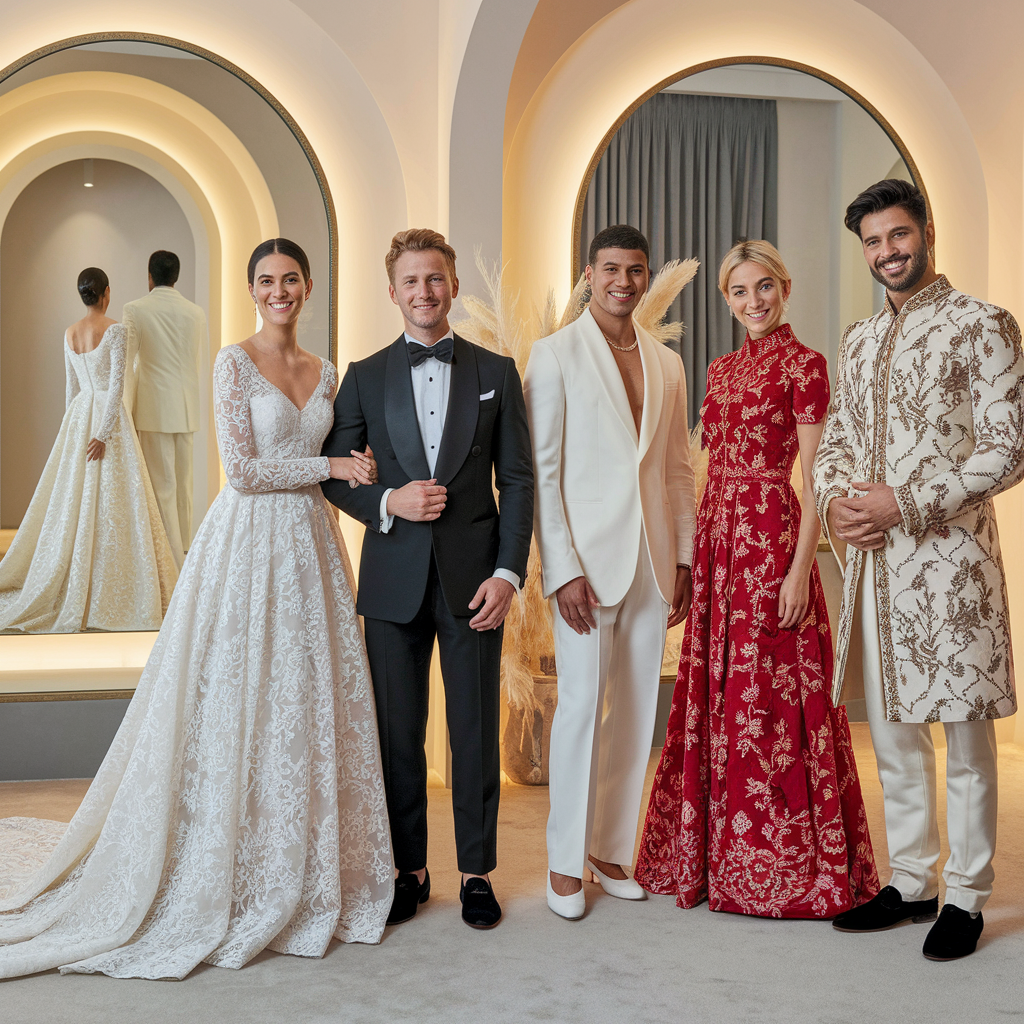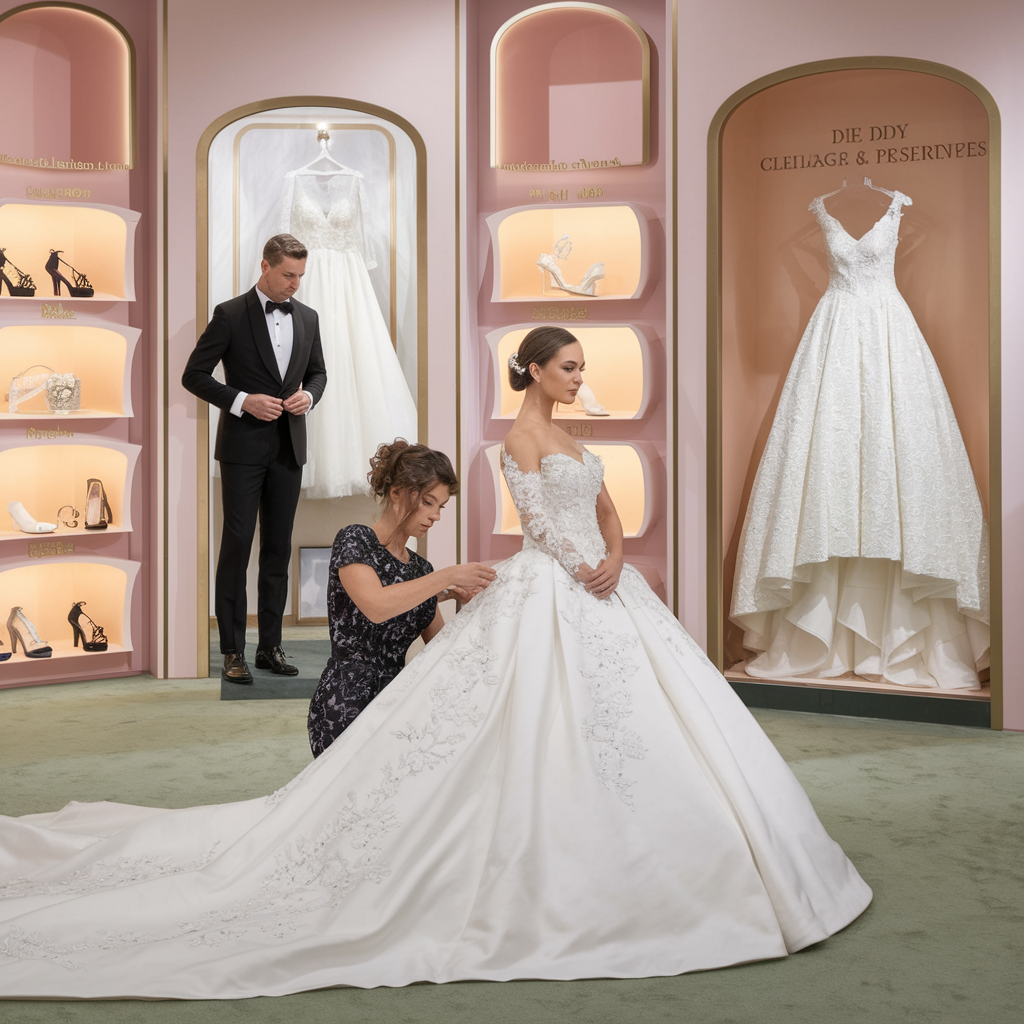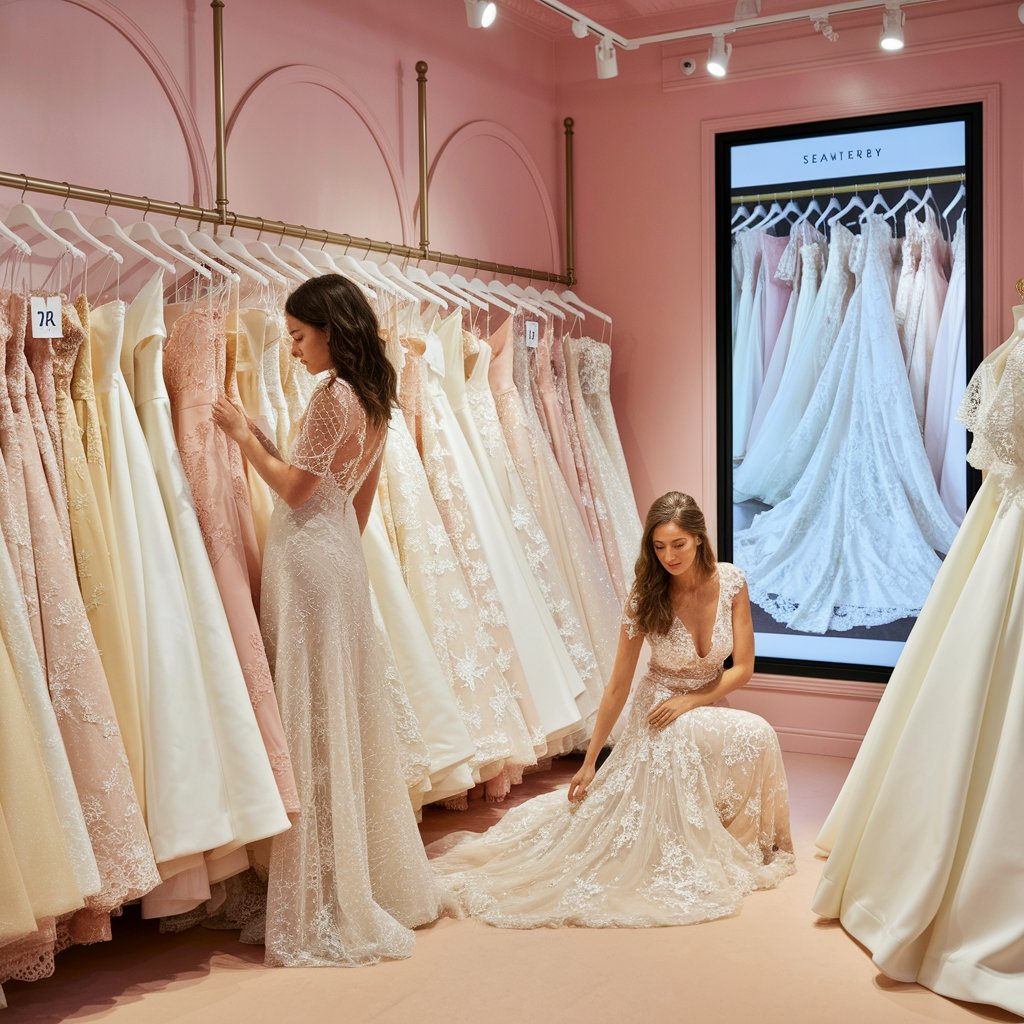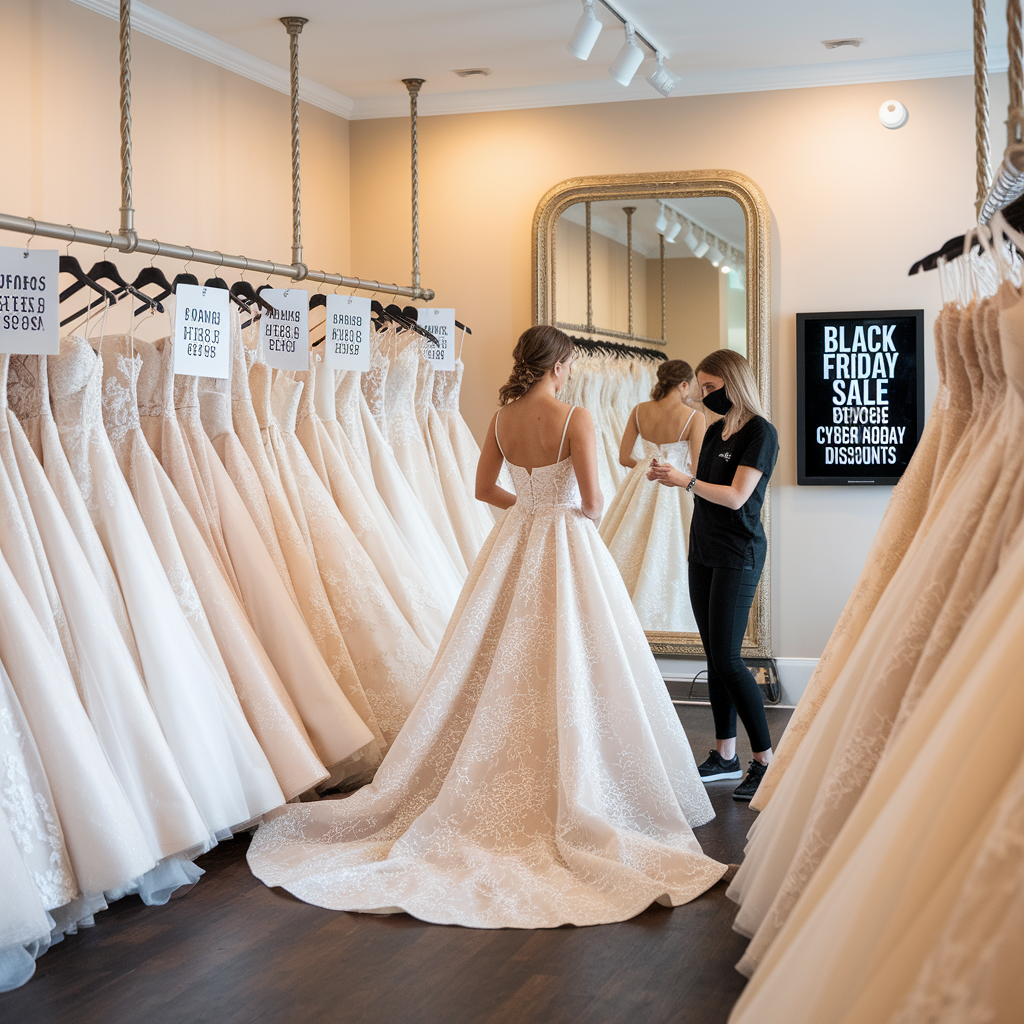Considerations for Cultural Wedding Attire & When to Order

For many couples, wedding attire is more than just a fashion statement—it’s a reflection of their culture, heritage, and traditions. Whether you’re wearing a beautifully embroidered lehenga, a tailored qipao, a regal kilt, or a stunning hanbok, selecting and ordering cultural wedding attire requires careful planning. Here’s what to keep in mind to ensure your outfit is perfect for your big day. 1. Understanding Cultural Traditions & Symbolism Many traditional wedding garments carry deep cultural significance, from specific colors and fabrics to embroidery patterns and accessories. Understanding the traditions behind your attire can help you make meaningful choices. 👘 Japanese Kimono: Often feature elaborate patterns symbolizing happiness, longevity, and prosperity.💃 Mexican Charro Suit & Folkloric Dresses: Celebrate heritage with intricate embroidery and vibrant colors.👗 Chinese Qipao/Cheongsam: Red is traditionally worn to symbolize good luck and prosperity.👰 Indian & South Asian Attire: Sarees, lehengas, and sherwanis often feature gold embroidery, signifying wealth and happiness.🦁 Scottish Kilts: Represent family heritage, with each tartan pattern linked to a specific clan. 💡 Tip: Research your cultural attire’s history and significance so you can incorporate elements that feel personal and meaningful. 2. Where to Shop for Cultural Wedding Attire Unlike standard wedding gowns or suits, cultural wedding attire is often sourced from specialty designers, international boutiques, or even family tailors in your home country. You may have several options for finding your perfect look: 🛍 Local Cultural Boutiques: Many major cities have specialty shops catering to specific cultures. Visiting in person allows you to try on options and customize your outfit.🌍 International Designers: If you’re ordering from an artisan in another country, be mindful of shipping times and potential customs delays.🧵 Custom Tailors: Many cultural outfits are custom-made, requiring measurements and multiple fittings.🎭 Family Heirlooms: Some couples choose to wear or alter a family heirloom for a meaningful touch. 💡 Tip: If shopping internationally, research reputable designers and confirm their experience with wedding attire. 3. When to Order Your Cultural Wedding Attire Since cultural wedding outfits are often handmade, require intricate detailing, and may come from international sources, ordering early is crucial. 📅 Recommended Timeline: 💡 Tip: Some cultural garments, like Indian bridal lehengas or embroidered gowns, may require hand-stitched embellishments that take months to complete—so plan accordingly! 4. Accessories & Additional Outfit Considerations Cultural wedding attire often includes specific accessories, footwear, and jewelry that complete the look. These details may also take time to source or customize. ✔️ Jewelry & Headpieces: Maang tikkas (South Asian headpieces), floral crowns, or cultural hair ornaments.✔️ Footwear: Mojaris (Indian), geta sandals (Japanese), or leather ghillie brogues (Scottish).✔️ Veils & Scarves: Dupattas, mantillas, or other culturally significant coverings. 💡 Tip: If wearing multiple outfits (e.g., one for the ceremony and one for the reception), coordinate your timeline so all pieces arrive in time. 5. Fittings & Final Adjustments Once your attire arrives, you may need alterations to ensure a perfect fit. Schedule fittings well in advance to allow for adjustments. 🔹 First Fitting: Ideally 2-3 months before the wedding to assess any major alterations.🔹 Final Fitting: 2-4 weeks before the wedding for last-minute tweaks. 💡 Tip: If you’re getting married abroad and bringing your attire with you, store it carefully in a garment bag to avoid wrinkles or damage. Final Thoughts Your wedding attire is a beautiful way to honor your heritage and culture while celebrating your love. By planning ahead, researching your options, and working with skilled designers or tailors, you’ll ensure your outfit is both meaningful and stunning on your special day. No matter what you wear, your wedding look should reflect who you are and what matters most to you. Happy shopping! ✨💍
Shopping for Your Wedding Attire: A Guide for Every Couple

Choosing your wedding attire is one of the most exciting parts of planning your big day! Whether you’re looking for a classic white dress, a sleek tuxedo, a modern jumpsuit, or a cultural ensemble, finding the perfect outfit is about feeling confident and comfortable as you say, “I do.” No matter your style, gender, or budget, here’s how to navigate the process of shopping for wedding attire. 1. Start Early to Avoid Stress Unlike everyday clothing, wedding attire often requires months of preparation. If you’re ordering a custom outfit, buying a gown that needs alterations, or coordinating looks with your wedding party, shopping early is key. 📅 Recommended Timeline: 💡 Pro Tip: Sample sales and off-the-rack purchases can save time and money, but be prepared for limited sizes and styles. 2. Set a Realistic Budget Before you start shopping, decide how much you’re willing to spend—not just on the outfit itself, but also on alterations, accessories, and post-wedding cleaning. 💰 Hidden Costs to Consider: 💡 Money-Saving Tip: Shopping during Black Friday, seasonal sales, or sample sales can lead to major discounts on both wedding dresses and formalwear. 3. Explore Different Shopping Options Not all couples follow the same path when it comes to wedding attire. Consider different avenues based on your budget, timeline, and personal style: 🛍 Boutiques & Bridal Shops: Best for those looking for a traditional shopping experience with expert guidance.🛒 Online Retailers: Convenient for those who prefer trying on outfits at home, but check return policies carefully.🎭 Custom & Cultural Designers: Ideal for those wanting an outfit that reflects their heritage or unique style.📦 Rental Services: A great option for high-end suits, tuxedos, and even bridal wear at a fraction of the price.🔄 Secondhand & Vintage Shops: Perfect for sustainable shoppers looking for one-of-a-kind pieces. 💡 Pro Tip: If buying online, order multiple sizes if possible and leave enough time for exchanges or alterations. 4. Prioritize Comfort & Fit No matter what you wear, comfort is just as important as style. You’ll be in your wedding attire for hours—walking, dancing, sitting—so make sure it feels good! 👗 For Dresses & Gowns: 🤵 For Suits & Tuxedos: 5. Don’t Forget Accessories & Final Touches Your attire is just one piece of the puzzle—accessories, shoes, and undergarments complete the look. ✔️ Shoes: Choose something stylish but comfortable enough for hours of wear.✔️ Jewelry: Keep it simple if your outfit is intricate, or add sparkle if your look is minimalist.✔️ Outerwear: If your wedding is in colder months, consider a chic jacket, cape, or shawl.✔️ Undergarments & Shapewear: Make sure they work with your attire and won’t show through. 💡 Pro Tip: Schedule a final fitting a few weeks before the wedding to ensure everything fits perfectly. Final Thoughts Shopping for wedding attire should be a fun and exciting experience, no matter what you wear! By starting early, setting a budget, exploring different options, and prioritizing comfort, you’ll find the perfect look that makes you feel amazing on your special day. No matter your style, size, or budget, there’s a wedding outfit out there that’s perfect for you. Happy shopping! 💍✨
The Hidden Costs of Wedding Attire: What to Budget for Beyond the Dress

Finding the perfect wedding dress (or suit) is a major milestone in your wedding planning journey, but the price tag on the dress itself isn’t the only cost you need to consider. Many couples are surprised by the hidden expenses that come with wedding attire, from alterations to preservation. To help you avoid any unexpected surprises, here’s a breakdown of the extra costs you should budget for when it comes to your wedding look. 1. Alterations: The Cost of the Perfect Fit No matter how stunning a dress or suit looks off the rack, it’s rare to find something that fits perfectly without alterations. Almost every bride and groom will need at least minor tailoring to ensure their attire fits like a dream. 💰 Average Cost: 👗 Common Dress Alterations: 💡 Money-Saving Tip: The more detailed your gown (beading, lace, layers), the more expensive alterations can be. Choose a dress that already fits well to reduce alteration costs! 2. Undergarments & Accessories The right undergarments can make or break your wedding day look. Many wedding dresses require special shapewear, seamless undergarments, or a strapless bra, all of which add to your final attire cost. 💰 Estimated Cost: 💡 Money-Saving Tip: Consider borrowing accessories from a friend or family member—it can double as your “something borrowed!” 3. Dry Cleaning & Wedding Dress Preservation After the wedding, you’ll want to properly clean and store your dress, especially if you plan to keep it as a keepsake. Wedding dress preservation is a professional process that protects the fabric from yellowing, moisture, and damage over time. 💰 Average Costs: 💡 Money-Saving Tip: Some bridal shops offer cleaning and preservation packages at a discount when you buy your dress—ask about this before purchasing! 4. Post-Wedding Suit & Tuxedo Costs For grooms and groomsmen, the cost of dry cleaning or returning a rented suit is another hidden expense to consider. Many tuxedo rental companies charge cleaning fees on top of the rental price, and if you purchase a suit, you may need to pay for dry cleaning after the wedding. 💰 Estimated Cost: 💡 Money-Saving Tip: If you plan on buying instead of renting, choose a suit in a classic style so you can wear it for future events! Final Thoughts While wedding attire is an exciting part of your big day, the final cost can be more than just the price tag on your dress or suit. By budgeting for alterations, undergarments, dry cleaning, and preservation, you’ll avoid surprise expenses and ensure you look (and feel) your best without financial stress. Want more wedding budget tips? Stay tuned for more insights to help you plan your dream day without breaking the bank!
Budget-Friendly Bridal: Alternative Ways to Save on Your Wedding Dress

Your wedding dress is one of the most special outfits you’ll ever wear, but that doesn’t mean it has to break the bank! If you’re looking for creative ways to save money while still finding a dress you love, there are plenty of alternatives beyond traditional bridal boutiques. From thrifting to borrowing, here are some smart ways to say “yes” to the dress without the hefty price tag. 1. Thrift & Secondhand Bridal Shops One of the best ways to score a designer dress at a fraction of the cost is by shopping pre-loved gowns. Many brides sell or donate their dresses after the big day, leaving plenty of stunning options available at secondhand bridal shops and online resale platforms. 📍 Where to Look: 💡 Tip: Check the return policy before buying online, and ask for detailed photos of any wear or alterations! 2. Borrow from a Loved One Wearing a dress from a family member or close friend is not only budget-friendly but also incredibly meaningful. Whether it’s your mother’s vintage gown, your sister’s modern dress, or even a friend’s simple slip dress, borrowing a wedding dress is a sentimental and sustainable choice. 👗 Things to Consider: 💡 Tip: If you love the idea of incorporating a family dress but still want something different, consider using lace or fabric from the original gown to create a custom veil or sentimental accessory. 3. Rent Instead of Buy If you’re open to not owning your wedding dress, renting could be a great way to wear a designer gown for a fraction of the price. Many bridal rental services offer high-end dresses at affordable rates, perfect for brides who don’t plan to keep their gown forever. 📍 Where to Rent a Wedding Dress: 💡 Tip: Always check rental policies regarding cleaning, damage fees, and return timelines to avoid unexpected costs. 4. Shop Non-Traditional Retailers Who says your wedding dress has to come from a bridal salon? Many mainstream retailers and department stores sell white dresses that could work beautifully for a wedding—often at a much lower price point. 📍 Affordable Dress Retailers to Check Out: 💡 Tip: Check bridal sample sales at traditional boutiques—these often include brand-new dresses at deep discounts! 5. Consider a Bridesmaid or Evening Gown A white or ivory bridesmaid dress or evening gown can look just as elegant as a traditional wedding dress but costs hundreds (or even thousands) less. Many brands, like Jenny Yoo and Amsale, design sleek and sophisticated bridesmaid gowns that work beautifully for a modern bridal look. 💡 Tip: If you want a fuller bridal look, consider adding a detachable overskirt or accessories to elevate the dress. Final Thoughts There are so many ways to save on your wedding dress while still feeling gorgeous on your big day. Whether you thrift, borrow, rent, or shop outside of traditional bridal salons, you can find a stunning gown that fits both your budget and your vision. At the end of the day, it’s not about the price—it’s about how you feel wearing it!
When to Go Wedding Dress Shopping: Timing Your Purchase for the Best Deals

Shopping for your wedding dress is an exciting experience, but did you know that timing your purchase strategically can help you save big? Bridal boutiques and designers often hold sales at certain times of the year, making it possible to score your dream gown at a fraction of the price. If you’re budget-conscious but still want a stunning dress, here’s a breakdown of the best times to shop and the sales you should look out for. 1. Black Friday & Cyber Monday Sales Most brides don’t realize that Black Friday isn’t just for electronics and clothing—it’s for wedding dresses, too! Many bridal retailers, both in-store and online, offer discounts on gowns and accessories during this shopping weekend. Some stores provide percentage discounts, while others have specific gowns marked down. If you’re open to shopping online, bridal e-commerce retailers like Veil by Davids and other online boutiques often participate in Cyber Monday sales, making it a great time to snag a deal from the comfort of your home. 💡 Tip: Do your research ahead of time! Many bridal shops and designers announce Black Friday sales in early November, so sign up for emails from your favorite stores to stay informed. 2. Sample Sales Throughout the Year Bridal shops frequently host sample sales, where they sell off floor models and discontinued dresses at deep discounts—sometimes as low as $400 for a designer gown! These events typically happen seasonally or when new inventory arrives, meaning you can find incredible deals multiple times a year. 📅 Common Sample Sale Seasons: 💡 Tip: Sample sales are first-come, first-served, and most dresses are final sale—so come prepared to make a decision quickly! 3. Trunk Shows with Special Discounts While trunk shows are not typically about sales, they do offer exclusive discounts and incentives on brand-new designer gowns. If you have a specific designer in mind, attending a trunk show could be a great way to get a discount (often 10–15% off) while also gaining access to the latest collections. 📅 Best Time to Look for Trunk Shows: 💡 Tip: Follow your favorite designers and local bridal shops on social media to stay in the loop about upcoming trunk shows. 4. End-of-Season Clearance Sales Just like regular fashion, bridal salons clear out their older styles to make room for new arrivals. You can often find markdowns on dresses from last season’s collections, particularly during late summer (August) and winter (December–January). 💡 Tip: If you love a specific dress but it’s a little outside your budget, ask the boutique if they’re planning any upcoming clearance sales—you might get lucky! Final Thoughts: When Should You Start Shopping? While these sales are great ways to save, it’s still important to shop early to allow time for shipping and alterations. Most made-to-order dresses take 4–6 months to arrive, and alterations can take another 2–3 months. If you’re shopping a sample sale, you’ll have your dress immediately, but you’ll still need time for tailoring. For a stress-free experience, start shopping 9–12 months before your wedding, and if you’re looking for the best deals, keep an eye out for these major sale events throughout the year!